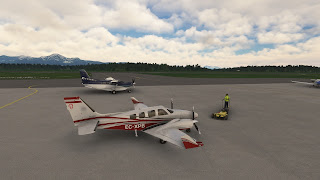Yanbu has been known at least for the last 2.500 years, as the starting point of the spice and incense route between towards the Mediterranean region. Nowadays, its population works mainly in the oil industry and refineries, although tourism is increasing due to its beaches and scuba-diving activity. And thanks to that, I found 5 PAX that wanted to travel to Madinah, going on with their personal tour around Saudi Arabia. So I accepted to carry them in this leg, since Madinah sounded like an interesting destination. It would be a direct flight, without landmarks, of barely 100 nm.
It was quite windy, with winds of 16 kt from 270. Luckily, the runway orientation was 280, so no much crosswind. I decided to climb fast, to avoid potential turbulences next to the ground.
Once in the air, I took a right pattern while I was climbing. The landscape was quite interesting as I gained altitude, since I could see the contrast between the coast, the city, the sandy plains and small mountains showing up in the horizon.
I quickly tuned Madinah VOR. It worked, so the technician at the FOB did a great job. I climbed until 7.500 ft., minimum safe altitude for the area. But, as I was approaching the mountains, I realised I was going to fly maybe too low. Considering the strong crosswind I had at that time, I decided to climb to 9.500 ft., just for safety.
And, after an interesting chain of mountains, I could see Madinah. Located on a plain between mountains. This large city, whose core is forbidden to non-muslims, is the burial of Muhammad and contains the Prophetic Mosque, second holiest site in Islam after the Great Mosque in Mecca. Actually, Madinah is an important pilgrimage destination, since together with Mecca and Jerusalem completes the three holiest cities in Islam.
Winds were more calm here, just 5 kt. I decided to land on runway 36, the shortests of both runways at Madinah airport. I made a long pattern to descend from 9.500 to about 4.000 ft. The final was quite nice, with the views of the city and nearby hills. Another landing to remember.
------
Technical details:
OEYN - OEMA
DCT
Distance: 100 nm
Distance: 100 nm
Average GS: 200 kt
Average alt.: 9500 ft.
METAR:





































































